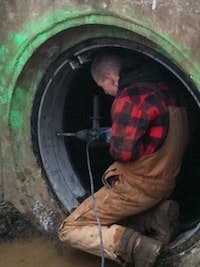A neighborhood in Kentucky was plagued by unpleasant odors that emanated from the community’s combined sewer system (CSO). The odors originated in a collection basin that collects storm water and discharges it through a pipe into the CSO.
The municipality unsuccessfully tried to mitigate the backflow of sewer gas from the CSO by adding plywood to cover most of the pipe. It even tried using toilet cake-type deodorizers to minimize odors. Realizing that the plywood could not effectively prevent the backflow of sewage and that it severely diminished the pipe’s flow capacity, the municipality realized that it had to find a more effective solution that would restore the flow capacity of the pipe and prevent the backflow of sewage and sewer gas. It selected a 48-in. Tideflex CheckMate inline check valve to solve the problem.
Eliminating odors
The CheckMate valve was easily installed into the existing structure by sliding the valve into the pipe and clamping it into place. Modification to the pipe or the existing structure was not required. The installation was completed within a matter of hours. Since it was installed, the CheckMate valve has proven to be completely effective in preventing the backflow of sewer gas. The municipality had concerns that the valve might not drain and would cause standing water, but officials inspected the collection basin after a large storm event and found it completely drained, proving that the CheckMate is self-draining with very low head loss.
In outfalls, storm water, CSO applications and SSO applications, the CheckMate’s custom-engineered, all-rubber unibody design prevents offending odors from backing up while still allowing water to discharge as needed. The CheckMate inline check valve will never corrode and is designed to eliminate the backflow of unwanted gases that typically result in complaints about odor from the general public.
Rainwater relief
In nearby Ohio, another municipality installed numerous 18- to 72-in. Tideflex TF-1 check valves in storm water outflows along the banks of the Ohio River to protect local businesses and properties from flooding. After a recent storm, the check valves proved their worth by protecting flood-prone areas of the town during a low-level flood event.
A local businessman was especially pleased with the success of the TF-1 check valves. His business has been flooded an estimated 15 times since 1984.
“Almost all of those floods could have been eliminated if these check valves had been installed sooner,” he said. “It cost around $6,000 to $10,000 to clean up and do repairs after each flood.”
A comparison of two similar low-level floods conducted by the city engineer’s office reinforced the difference that Tideflex TF-1 check valves can make to this businessman. Pictures taken of his property in 2007 show water surrounding one side of his building when the river level reached 32.6 ft. But in a more recent picture, the property and its surrounding areas remained dry when the river reached a level of 31.7 ft.
“That’s only 10 or 11 inches difference,” the businessman said. “At 32 feet, there is enough water around the property that we couldn’t drive into the lot. I would have to boat the staff in.”
The Tideflex TF-1 check valves prevent flooding by releasing storm water runoff during heavy rains out of low-lying areas. They also prevent rising river water from backing into the city’s storm water drainage system during low-level floods. The TF-1s remain closed until water pressure from the storm water drainage system forces them to open. When the river levels rise, the force of the water seals the valves from the outside. The check valves will not open until pressure from the inside of the valve is greater than outside pressure. The TF-1s will not prevent major flooding when the Ohio River overflows its banks, but they are expected to help reduce water levels by at least 4 to 5 ft during more frequent low-level floods.
Series TF-1 check valves are popular flood mitigation tools for riverside communities. The first Tideflex check valve, designed in the early 1980s for New York City, is still in operation today. TF-1s are inexpensive to install, and they can help save millions of dollars in flood damages over the course of their 25- to 30-year expected lives.



